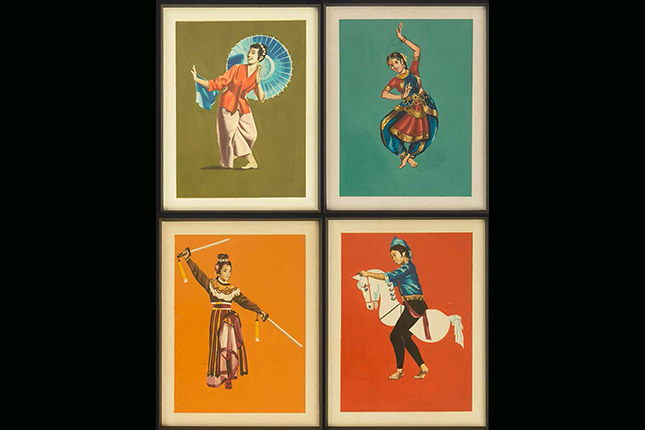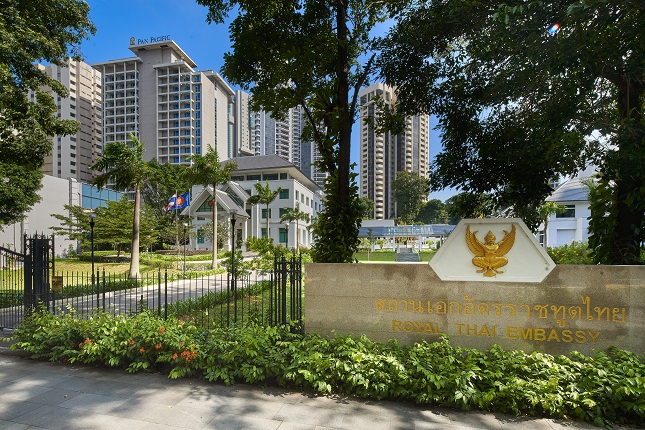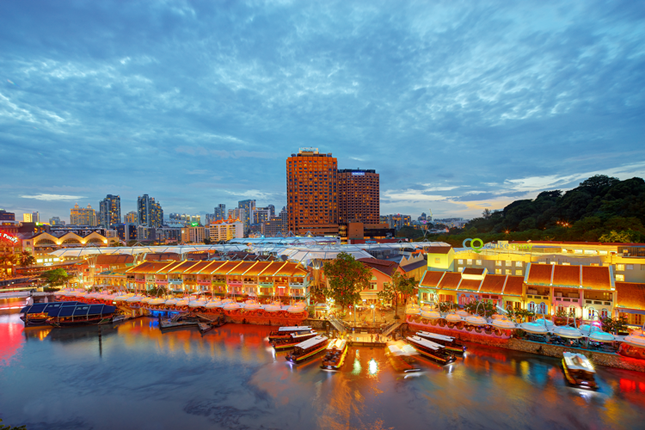Text by Lucille Yap
BeMuse Volume 5 Issue 4 - Oct to Dec 2012
Singapore and Thailand share close historical ties dating back to the 13th century when Singapore was under the Malay sultanate. The opening of the Kingdom of Siam (now Kingdom of Thailand) to foreign trade from 1855 drew Singapore closer to Siam via trade.

Singapore received the first royal visit from the Kingdom of Siam when His Majesty King Chulalongkorn made his first overseas visit as king to Singapore in 1871. It was during this period when Siam studied how Singapore, then a British colony, was administered, including its economic and social affairs, as well as the postal system. The advancement of the British postal system in Singapore inspired the Kingdom of Siam to introduce and develop the postal system in Siam. The first post office and stamp issue for Siam was inaugurated on 4 August 1883.

Singapore – A Postal Hub
Since its establishment as a trading post in 1819 by the British East India Company, Singapore was a postal and communication hub for states and countries in Southeast Asia. All written correspondence from countries in this region with the rest of the world, and vice versa, was done via Singapore. Incoming and outgoing foreign mail to and from Southeast Asian countries were collected in Singapore before being forwarded to their destinations.
Located at the crossroads of international shipping routes, Singapore’s unique geographical position placed it in a position to influence the postal arrangements of neighbouring countries – many of which followed this British settlement’s postal system closely when introducing new postal systems and extending old ones. The Kingdom of Siam was no exception.
Singapore continued to serve as an important collecting and forwarding hub until late 1800s when its neighbouring countries became members of the Universal Postal Union (UPU). As members of the UPU, which was established in 1874, they were able to send and receive international mail directly to and from foreign countries without having to route their mail to Singapore.
Modernising Siam
Siam was known to be a great entrepot centre in the 17th century. However, its efforts in diplomatic and commercial relations with foreign and Western countries were put to a halt by Burmese invasion in 1767. Although Burma did not retain control of Siam for long, Siam closed its door to the outside world and spent more than a hundred years to restore and reunite the country.
Siam began to resume external contacts during the reign of His Majesty King Nang Klao (Rama III 1824 - 1851). He reopened relations with Western nations and established trade with China. But it was during the reign of His Majesty King Mongkut (Rama IV 1851 - 1868) and later His Majesty King Chulalongkorn (Rama V 1868 - 1910) that Siam underwent tremendous transformation.
Diplomacy, Sovereignty and Modernisation
Faced with the pressure and threat of Western imperialist powers’ advances in colonising states and countries around Siam, King Mongkut kept these Western powers at bay by signing treaties with several European countries. United Kingdom was the first to succeed in signing a treaty with Siam in 1855. Signed by King Mongkut and Sir John Bowring, the Bowring Treaty in essence allowed foreigners to trade freely in Bangkok without the heavy royal taxes imposed on trade. The constructive treaty put Siam’s foreign relations on a positive note at a time when resistance was met with force. The Bowring Treaty set the tone of non-interference in Siamese affairs and respect for Thai independence, which was also observed by other Western powers.

Source: Collection of Dr Prakob Chirakiti.
The Bowring Treaty resulted in an increasing volume of trade between Singapore and Siam. Rice exports formed the biggest part of this trade. With the signing of more treaties with other foreign powers, trade grew by leaps and bounds. For example, ships visiting Bangkok from Singapore more than doubled, from 146 in 1850 to 302 in 1862. The total annual value of trade also rose from about 5.6 million baht in 1850 to about 10 million baht by 1868.
Capitalising on the good relationship with the Western powers, King Mongkut studied their form of government, administration, as well as their social and economic affairs. He undertook many social and economic reforms to modernise Siam.

King Chulalongkorn continued his father’s tradition of reform, abolishing slavery and improving the public welfare and administrative systems.

Singapore – An Inspiration to Siam
Singapore was the British centre in the region. There were many visits between British and Siamese officials. In 1861, King Mongkut sent Chao Phraya Sri Suriyawongse Juang Bunnag and Prince Krommamun Vishnunarth Nibhadhorn to study how Singapore was administered. As a result, modern technology such as the construction of roads and bridges was brought to Siam.
During the start of the reign of King Chulalongkorn, the progress of Singapore, Java and India had deeply impressed the young king. British and Dutch colonial government and administration – not the states in Europe – were his models. There are two main periods of reform during his reign: the first from 1873 to 1874; and the second, after 1892. The reforms were related to his travels to Singapore and Java in 1871 and his subsequent visits to these same places in 1896 and 1901.
In 1881, with a view to establish post offices in the kingdom, an officer was sent to Singapore to gain insight into the postal system. Siam hoped to establish direct postal communication with the rest of the world, and there was no post office in the kingdom at that time.
Introduction of Postal System in Siam
British Consulate in Bangkok
The signing of treaties between Siam and foreign countries allowed these countries to establish their consulates in Siam. The need to communicate via letters and correspondence with other consulates and with their home countries stressed the need for a postal system. At that time, there was no postal service in Siam. The people of Siam sent letters through messengers or friends who were travelling within or out of the country.

In 1867, the British Consulate was the first entity in Siam to introduce the system of post. With that, all international mailing services were provided by and dependent on the British Consulate.

Straits Settlements Stamps Used in Bangkok
When the British Consulate Post Office was set up in Bangkok, Siam did not have its own stamp. British India stamps, which were also used in the Straits Settlements (Malacca, Penang and Singapore), were used by the British Consulate Post Office until 1867 when they were replaced by Straits Settlements stamps.
During this early period, outbound mail must be sent out from Bangkok to Singapore, and thereafter forwarded to other countries. The letters and packages were thus cancelled in Singapore with Singapore postmarks. This practice continued until 1 July 1885 when Siam joined the UPU which coordinates the international postal system, and started its own international postal services.
Straits Settlements Stamps Overprinted with ‘B’
In April 1882, the branch of the Singapore post office established in Bangkok was permitted by the United Kingdom to operate postal services in the city, as sending messages was in great demand. The Straits Settlements stamps were overprinted with the Roman alphabet ‘B’, which stood for ‘Bangkok’, the place from where the letters were mailed.

After Siam started operating its own postal services in 1883 and became a member country of the UPU on 1 July 1885, the British postal services in Siam and the use of the stamps printed with the letter ‘B’ were terminated.
Local Stamps for Palace Use
In 1875, when the British Consulate was still offering postal services in Siam, His Royal Highness Prince Bhanurangsi Sawangwongse, King Chulalongkorn’s younger brother, published a daily newspaper named ‘COURT’ or ‘Government News’ with a group of the royal family’s members. The newspaper was distributed by dispatch to high-ranking officials and close members of the royal family, and Prince Bhanurangsi Sawangwongse issued a stamp as evidence of payment for the delivery service. This stamp, referred to as ‘Local Stamp’, featured a portrait of Prince Bhanurangsi Sawangwongse. They were also used for letters sent to a specific area.


Following this, Prince Bhanurangsi issued another series of stamps printed in England named ‘The Royal Family’. It was used only by members of the royal family in communicating government news.
Siamese Postal System
In 1880, Chao Muen Samerjairaj, a courtier who had seen the postal system in foreign countries, made an appeal to King Chulalongkorn to establish a postal system in Siam for the benefits of the general public and the government.

He said:
“It is important indeed for the trading in accordance with the international practice to know exactly where to receive and send the correspondences, which is called postal service, and this will be beneficial to the nation and other countries as well.”
On 2 July 1881, King Chulalongkorn appointed Prince Bhanurangsi as Director-General of the Post and Telegraph Department. It was a rather challenging endeavour for the prince, as the postal services were very new in the Siamese society. The registration of house numbers and last names had not commenced at that time. Moreover, a number of people disagreed with the project, fearing that it might not worth the investment.
Inauguration of the Postal System
On 4 August 1883, Prince Bhanurangsi, Director-General of the Post and Telegraph Department, proclaimed the inauguration of postal services, which would be on trial within the area of Bangkok. Letters were accepted and sent within the city.
After 48 days, the overwhelming number of Siamese people using the services at the post office amazed King Chulalongkorn. The king mentioned the postal services in the Royal speech on his birthday on 20 September 1883:
“ I had no idea that the Siamese use letters in this huge amount ... Post Office providing the services of receiving and delivering mails within Bangkok surprises me due to the fact that the Siamese use a great amount of letters. This inspired me to expand the service throughout the Kingdom for the benefit of trading and correspondence of government sector. Later, I hope to invite the Director-General of Germany Postal Service and apply for a membership of Postal Union, which will allow for Siamese Postal Service to operate the mailing service around the world.”
First Stamp Issue in Siam
Siam issued its first set of postage stamps on 4 August 1883. The stamps, known as ‘Solot’, featured the portrait of King Chulalongkorn. Intended for domestic use only, the stamps bore no country name. They were designed by Mr William Ridgeway, an English designer and engraver, and were printed by the Waterlow & Sons Printing C Ltd, England.

When Siam joined the UPU on 1 July 1885, stamps were issued and designed in accordance with the UPU regulations, so that they could be used both within the country and overseas. The word ‘SIAM’ was added and denominations were in both Thai and Arabic numerals.
With these changes, the use of British Straits Settlements stamps for outbound mail was no longer needed. This led to the closure of the British Consulate Post Office in Bangkok.
Lucille Yap is Senior Curator, Singapore Philatelic Museum.















